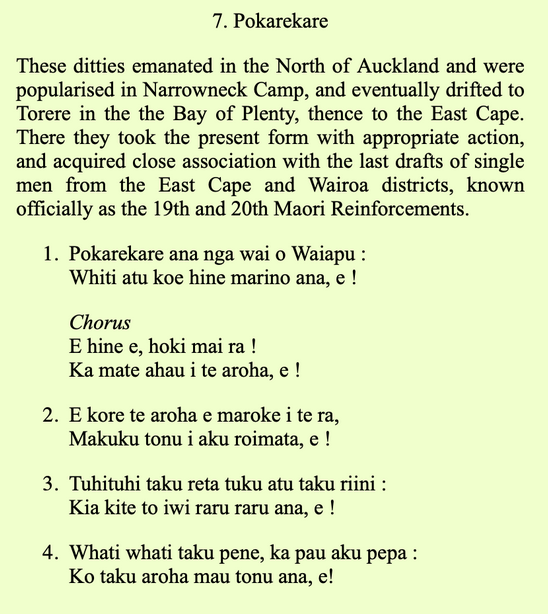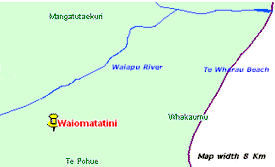 Narrowneck Camp was at Takapuna, Auckland. After World War One started in late 1914, Maori soldiers from different tribal areas met there and swapped songs. The ditties would not have got to the East Coast until a year or so later. Modified by Pariare Tomoana in 1917Sentiments similar to these Northland words were apparently expressed in an April 1912 love-letter by Paraire Tomoana, a divorced 40-year-old man, in a bid to win the hand of 18-year-old Kuini Ripeka Raerena (Ryland). This has led to a mistaken belief that Paraire Tomoana actually wrote the song. In the Daily Telegraph, Hastings. August 6th, 1987, Ngatai Huata said that Pokarekare Ana was originally written as a letter in 1912 to Queenie Ryland who lived at Tokomaru Bay. Unfortunately, the letter in question was never produced to support this claim. In March 2002, on a tv documentary about Pokarekare Ana, one of Ms. Huata's brothers said the family never heard this 1912 story from their parents or grandparents: they heard it much later from "others." This would suggest that their parents or grandparents had never heard of the 1912 story either. Whatever its origins, the important thing is that Ms. Huata's very praise-worthy actions put the song safely under the cloak of Tomoana whanau guardianship, and thus protected it from political exploitation. Apirana Ngāta's daughter in about 1923 In the same 2002 television documentary, descendants of Sir Apirana Ngāta, in a March, claimed that Pokarekare Ana originated when Ngata's very talented daughter, Tai, ran away from her studies to live with a bushman, Sam Green, in the headwaters of the Waiapu River. ('Come back girl... My love will be forever moistened by my tears') However a
1995 death notice reports that "Heneriata
Whaingata (Tai) Green, a daughter of Sir Apirana
Ngata and thought to be the first Maori woman to
attend a NZ university, died in Rotorua aged
90." This places her entry into university
as a 17-year-old to about 1922, after the song had
already been published. Different song-writing stylesThe different writing style of each verse suggests that different hands helped shape them. Pokarekare ana nga wai o Waiapu . . . This verse is a very effective image of the soul-deep trembling anxiety of new love. A poet who was very proficient with with the use of imagery wrote these lines. Tomoana tried to express this anxious love in another song Tahi nei taru kino, as "He aha kei taku uma pākikini nei ? - What is this within my chest that pinches so? But this clumsy line always attracted jokes about indigestion, and so it is not sung any more. Tuhi-tuhi raku reta tuku... taku... kia kite . . . raru raru . . . Look at all that all those repetitive syllables! This verse was written by someone who was very proficient with word-play. E kore te aroha e maroke i te ra makuku tonu i aku roimata e. While this verse speaks straight from the heart, without imagery or word-play. Tomoana and Ngata probably reworked the ditties slightly to portray the local story of the love of a Hawkes Bay man (Tomoana) for an East Cape girl (Kuini). This would have given the song great power in strengthening the bonds of comradeship of the departing Hawkes Bay and East Cape fighting men. Notice that the first time credit is given to Tomoana's individual effort in connection with the song is on a 1927 music sheet which says"words and music arranged by P H Tomoana." Arranged by, not "composed by". And again, in 1949, Inia Te Wiata gives its composition as"Trad., arr. Piripata." Tomoana's DNZB biography says that in June 1917 he organised a song and dance group that gave performances to raise money for the Maori Soldiers' Fund. He took 55 men and women to perform at a wedding at Ngata's marae of Waiomatatini near the East Cape. This was when the "others" heard it sung first, and over the decades it become combined in their minds with the love poem of similar sentiment that Tomoana expressed in a letter to Kuini in 1912, and sang to her at Gisborne in 1913. Conclusion"A composition was generally the work of a group, but centered around the person whose passion was its inspiration. This might be expected of a people which had a strong sense of cooperation... Most songs were composed as a group effort, even though one person was credited with the song. The same is still happening with action songs... Songs were reworked because the melody and symbolism of the words were liked, and to make the song appropriate to the new context." Pokarikari Ana was probably a result of this group process. Here is a scenario of its origins.Pariare Tomoana composed some verses with similar sentiments to win the hand of Kuini in 1912, and may have sung them at Gisborne in 1913. And some Northland parent or lover composed these lines to sing to a boy who was going off to the war E kore te aroha ('My love will be forever moistened by my tears') with the chorus "E tama e, hoki mai ra . . . ( 'O darling boy, come back to me . . . ') The boy and his mates took these lines south to Narrowneck army camp at Takapuna, Auckland in 1914. Then other recruits added more verses, and reworked them, and soldiers home on final leave early in 1917 brought the verses to Torere in the the Bay of Plenty, where Tomoana heard them. He then went to visit Apirana Ngata at Waiomatatini, near the East Cape, where the two men polished the melody, and reworked the Northland ditties to portray the local story of the love of a Hawkes Bay man (Tomoana) for an East Cape girl (Kuini). This would have given the song great power in strengthening the bonds of comradeship of the Hawkes Bay and East Cape men who were then being recruited as the 19th and 20th Maori Reinforcements. In June 1917, Tomoana organised a song and dance group that gave performances to raise money for the Maori Soldiers' Fund. The members of the group prepared new action songs for these performances. It would have been through Tomoana's group that "...they took the present form with appropriate action." (Tomoana 1921) Tomoana's concert party performed Pokarekare as an action song for the 19th and 20th Maori Reinforcements before they departed on July 7th, (as combat engineers, to construct trenches, under fire, in the swamps of Passchendale). In July 1917, Tomoana's concert party went up to the East Cape and performed at a Waiomatatini wedding. This was when the "others" heard it sung first, and over the decades it become combined in their minds with the love poem of similar sentiment that Tomoana expressed in a letter to Kuini in 1912, and had sang in at Gisborne in 1913. Credit was first given to Tomoana's individual effort in connection with the song is on a 1927 music sheet which says "words and music arranged by P H Tomoana." Tomoana's grand-daughter was misled by the fading memories of the "others." But she acted in accordance to established Maori custom by attributing the song to her grandfather ...whose passion ...was its inspiration (Arapete Awatere, 1973). By doing this, she has effectively protected Pokarekare Ana as a cultural treasure. World War OneEarly performancesIn many cultures today |